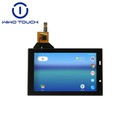Touch screen glass cover is mainly used in the outermost layer of the touch screen, as a protective layer and interface with the user direct contact. It not only protects the touch screen from external impacts and scratches, but also has the functions of oil resistance, fingerprint resistance and enhanced light transmission. At the same time, through a special process, such as printing different colours, patterns and markers, can also play a role in decorating and beautifying the product.
However, the impact of glass thickness on touch screen sensitivity is significant, mainly in the following aspects:
1. Signal attenuation: Touchscreens usually detect touch movements through capacitive, resistive or optical principles. When the glass layer is thick, the touch signal may experience some degree of attenuation as it travels through the glass layer. This attenuation may make it difficult for the touch screen system to accurately recognise or respond to slight touch movements, thus reducing sensitivity.
2. Response Time: A thicker layer of glass increases the time it takes for the signal to travel from the finger to the touchscreen sensor. While this time delay is negligible in most cases, it can be a critical factor in the user experience in application scenarios that require high speed response.
3. Optical Interference: While high-quality glass typically has excellent light transmission, excessively thick layers of glass may increase the refraction and reflection of light, especially at the edges of the screen or where there are irregular shapes. This optical interference may affect the visual clarity and touch accuracy of the touchscreen.
4. Weight and Thickness: In addition to directly affecting sensitivity, thicker glass layers can increase the overall weight and thickness of the touchscreen. This may affect the portability and feel of the device, indirectly affecting user satisfaction with the touchscreen and frequency of use.

The following measures can be taken to address the impact of glass thickness on touchscreen sensitivity:
1. Choose the appropriate thickness of glass: When designing and selecting a touch screen, the appropriate thickness of glass should be chosen according to specific application scenarios and needs. Generally speaking, under the premise of ensuring strength and durability, thinner glass should be chosen as much as possible to improve the sensitivity of the touch screen.
2. Optimise the lamination technology: Adopting advanced lamination technology can reduce the air layer between the glass and the touch screen, reduce the reflection of the interlayer interface, and improve the light transmission rate and image contrast, thus making up for the impact of glass thickness on sensitivity to a certain extent.
3. Improve glass quality: Choosing high-quality glass materials, such as glass with high light transmittance, low reflectivity, high hardness and abrasion resistance, can further enhance the sensitivity and user experience of the touch screen.
4. Software optimisation: Calibrate and optimise the sensitivity of the touch screen through software algorithms, which can make up for the shortcomings of the hardware to a certain extent and improve the response speed and accuracy of the touch screen.




